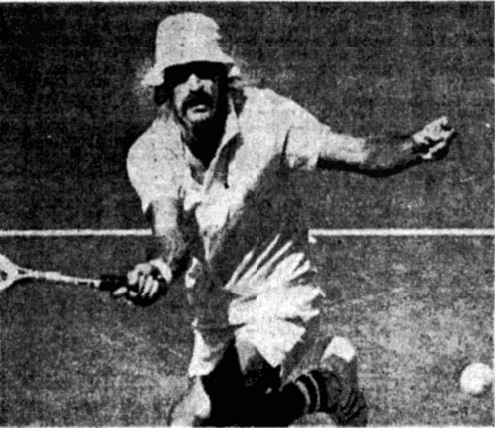Davis Cup semi-finals were supposed to be drama-packed clashes of titans. When the United States hosted Romania for a place in the 1973 Cup final, there were titans present, but 6,000 fans waited in vain for the drama.
Stan Smith and Ilie Năstase had already faced off in three late-round Davis Cup ties, not to mention a Wimbledon final. The 1972 Davis Cup final had been one for the ages, with Smith and company venturing into hostile territory in Bucharest. Confronting watered-down clay, biased officials, gun-toting “translators,” and the imposing duo of Năstase and Ion Țiriac, the Americans somehow pulled out a victory.
The United States had spent their entire victorious 1972 campaign on the road, thwarting the hopes of local fans in Jamaica, Mexico, Chile, and Spain before defying the locals in Bucharest. Now they could reap the rewards.
This time, the Romanians trekked to the Round Hill Country Club in Alamo, California, just outside of San Francisco. Canadian referee Fred Bolton would treat both sides fairly. Țiriac, split from Năstase and easing into retirement, was missing. And the matches would be played on cement–a surface that Țiriac’s replacement, Toma Ovici, had encountered only twice before.
Opening day offered few surprises. Smith destroyed Ovici, a result so universally anticipated that the Romanian said that he was proud to have won nine games. Năstase had an equally easy time of it against American veteran Marty Riessen. Riessen mounted a challenge in the second set, but the result was lopsided: Năstase never lost his serve, and he broke five times.
The sellout crowd could do little apart from fidget and engage in idle speculation. Năstase had recently made the news for cursing out an umpire in Cincinnati, but he behaved himself here. When he mildly protested a line call, fans began to ride him–anything to break up the monotony of another lopsided match.
The American faithful also wondered if Riessen was a good choice. He certainly didn’t threaten the Romanian star. The 31-year-old hadn’t played Davis Cup since 1967, ruled out of the competition by his status as a contract pro. Bringing him back meant booting Tom Gorman, a younger player who had won four Cup rubbers in the last two years. Captain Dennis Ralston said he was opting for experience. There was little else to separate the two. When the ATP released its first-ever rankings list later that month, Riessen and Gorman were placed 14th and 15th, respectively. My retrospective Elo ratings have them at 1,967 and 1,964–a virtual tie.
The next day, the doubles continued to follow the script. Smith and Erik van Dillen straight-setted Năstase and newcomer Ionel Sânteiu. The speedy Sânteiu was better than the hosts expected. But he, like Ovici, was unaccustomed to playing on cement, and he had partnered Nastase only twice before.
On August 20th, the Romanians would make one last push to defy the chalk. If Ovici could upset Riessen, a fifth-rubber showdown between Smith and Năstase would determine which side faced Australia or Czechoslovakia (okay, Australia) in December for the championship.
While Riessen wasn’t a unanimous choice, he was more than adequate to finish the job. His big serve was more appropriate for the cement than Ovici’s clay-tuned game, and he turned up the pressure from the start. The veteran won 16 of the first 18 points of the match, as well as the opening point in 19 of the first 24 games. The Romanian fought out a triple-deuce game to sneak off with the second set, but Riessen always seemed to have the matter in hand. He secured the victory for the Americans, 6-1, 4-6, 6-1, 7-5.
The fans, finally, had something to get excited about. Yes, they could celebrate, but more importantly, Smith and Năstase would finally line up in singles. In the 1970s, as long as the schedule allowed, dead rubbers were played. They even counted for Grand Prix points. Năstase had won the lucrative 1972 Grand Prix and was slogging out a punishing 1973 schedule in an effort to defend the crown. Even though Romania’s Cup campaign was done, Nasty had good reason to take this one seriously.
For the fourth time in their long rivalry, the two stars went five sets. Năstase broke at 6-5 to take the first. From there, Smith’s serve allowed the American to take control. The surface, once again, worked in the home team’s favor. Big Stan claimed the Grand Prix points, 5-7, 6-2, 6-3, 4-6, 6-3.
The 1973 final would be held in Cleveland, once again on a surface chosen to suit the home team. All the Americans could do now was wait: Australia and Czechoslovakia wouldn’t settle the other semi-final until November. With Rod Laver, John Newcombe, and Ken Rosewall suiting up for the Aussies, Smith and the gang would take any edge they could get.
* * *
This post is part of my series about the 1973 season, Battles, Boycotts, and Breakouts. Keep up with the project by checking the TennisAbstract.com front page, which shows an up-to-date Table of Contents after I post each installment.
You can also subscribe to the blog to receive each new post by email:
